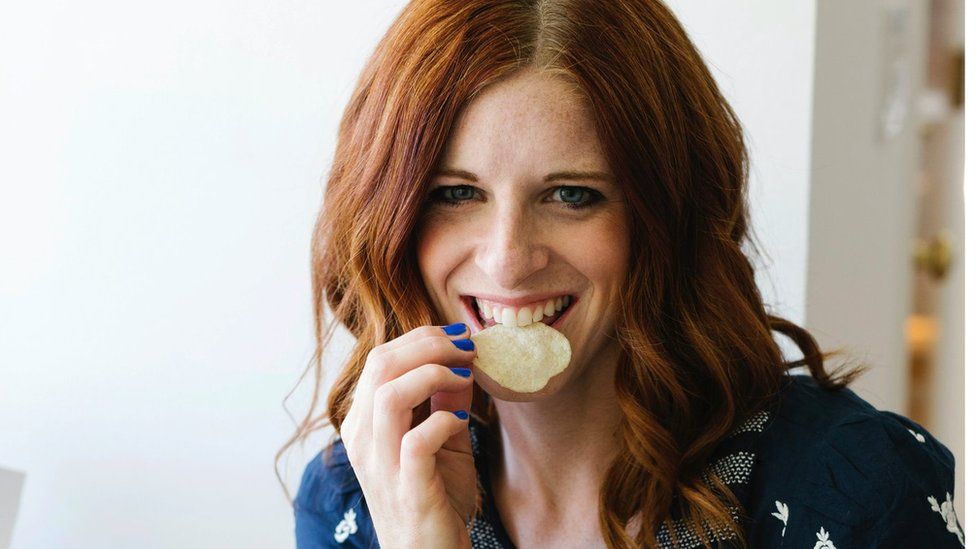[Health] Serving-size labelling leaves many confused- Which? survey
Image source, Getty ImagesBy Smitha MundasadHealth reporter People struggle to estimate portion sizes for food such as chocolate, crisps and cheese, a survey of 1,265 Which? subscribers suggests.They may need more help to assess how healthy products are, the consumer group says.A third guessed a 185g (6.5oz) tube of Pringles contained two to four portions. But the packaging says it has six to seven - some 13 crisps each.On a 220g box of Quality Street, the label suggests a portion is two sweets.Unrealistic recommended serving sizes can mislead people into thinking they are consuming fewer calories, and less fat, sugar or salt, than they actually are, Which? says.This video can not be playedTo play this video you need to enable JavaScript in your browser.Media caption, Measure food with your fistsLabelling was really valuable but needed to be based on "meaningful and consistent" portion sizes, Which? nutritionist Shefalee Loth said."People can be confused by inconsistent and unrealistic
![[Health] Serving-size labelling leaves many confused- Which? survey](https://www.9020blog.com/uploads/images/202307/image_750x_64c37094d5e03.jpg)

People struggle to estimate portion sizes for food such as chocolate, crisps and cheese, a survey of 1,265 Which? subscribers suggests.
They may need more help to assess how healthy products are, the consumer group says.
A third guessed a 185g (6.5oz) tube of Pringles contained two to four portions. But the packaging says it has six to seven - some 13 crisps each.
On a 220g box of Quality Street, the label suggests a portion is two sweets.
Unrealistic recommended serving sizes can mislead people into thinking they are consuming fewer calories, and less fat, sugar or salt, than they actually are, Which? says.
This video can not be played
To play this video you need to enable JavaScript in your browser.
Measure food with your fists
Labelling was really valuable but needed to be based on "meaningful and consistent" portion sizes, Which? nutritionist Shefalee Loth said.
"People can be confused by inconsistent and unrealistic serving sizes and the way that manufacturers provide these can sometimes make it difficult to assess just how healthy a product is," she said.
Most of those surveyed said:
- supermarket "meal deals" were the ideal portion size for one person - but the drink and accompanying snack are often designed for two, a 300ml (half a pint) carton of orange juice, for example, or a 60g packet of mixed nuts
- a 225g supermarket pack of halloumi cheese was the right amount for two to four people - but the packaging suggests it would be enough to feed seven
The Which? report found some well-known brands of crisps and chocolate were available in a range of pack sizes, with inconsistent portion sizes across these different packs.

Which? asked 229 people to pour themselves a glass of wine or juice at home and then measure how much they had served.
- About half of white-wine drinkers poured more than the official small serving of 125ml
- Some 54% of orange-juice drinkers poured more than the recommended daily limit of 150ml
A Food and Drink Federation representative said a range of portion sizes were available "to help consumers achieve a healthy balanced diet and to meet the varying requirements of families".
"Food and drink manufacturers are committed to providing clear and accurate information and voluntarily include traffic-light labelling on the front of packs, so people can make an informed decision on the food they buy," the representative added.
Most nutrition information on packaging is listed per 100g, in line with government guidance.
Related Topics
What's Your Reaction?








![[Uk] 'Litany of avoidable failures' in Edinburgh tram project](https://www.9020blog.com/uploads/images/202309/image_650x433_650a6ed582769.jpg)




![[Entertainment] Idris Elba: Actors in video games like Phantom Liberty is 'sign of the times'](https://www.9020blog.com/uploads/images/202309/image_750x415_6512c6d8254e4.jpg)
![[World] Ukraine war: Russia demands UN court throw out case against it](https://www.9020blog.com/uploads/images/202309/image_750x415_650957bed2ad4.jpg)
![[Entertainment] Olivia Rodrigo: Second album Guts goes straight to number one in UK](https://www.9020blog.com/uploads/images/202309/image_750x415_65055ae91776d.jpg)

![[Business] BMW investment secures future of Mini factories](https://www.9020blog.com/uploads/images/202309/image_750x415_64ffe58cc2284.jpg)